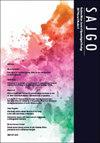Tumour and treatment factors influencing the outcome of chemo-radiation in stage IIB cervical cancer: a single institution experience
IF 0.3
Q4 OBSTETRICS & GYNECOLOGY
Southern African Journal of Gynaecological Oncology
Pub Date : 2018-01-02
DOI:10.1080/20742835.2018.1441694
引用次数: 12
Abstract
Objective: This study examined the effects of treatment and tumour factors on the overall survival of patients completing chemo-radiation for stage IIB cervical cancer, to identify modifiable factors that might improve outcome. Materials and methods: A retrospective audit was undertaken of 228 patients with stage IIB cervical cancer treated between 1995 and 2010, who received chemo-radiation with at least 45 Gy external beam radiation, two to four brachytherapy sessions, and one to six weekly cycles of concurrent cisplatin (40 mg/m², capped at 60 mg/week). Results: Mean total dose to Point A from external beam radiation and brachytherapy was 83 Gy (range 61–96 – expressed as the linear quadratic equivalent dose to 2 Gy/fraction). Mean overall treatment time was 45 days. The average weekly haemoglobin (AWHB) during treatment was 11.6 g/dl (range 8.8–15.5). Overall, one-third of patients received blood transfusions before or during chemo-radiation, and two-thirds of patients completed five or six cycles of weekly cisplatin. Reasons for fewer than five cycles were scheduling failures, neutropenia, renal impairment and side effects. No outcome differences were observed for Monday vs. Thursday cisplatin administration. The five-year overall survival was 60%. Patients completing fewer than six cycles had a worse survival (55 vs. 76%, p = 0.02). By multiple regression for survival only six cycles of cisplatin, squamous histology and AWHB >10 g/dl were significant. Conclusions: Maintaining HB >10.0 and administering six cycles of weekly cisplatin are associated with better survival from chemo-radiation for stage IIB cervical cancer.影响IIB期宫颈癌化疗结果的肿瘤和治疗因素:单一机构经验
目的:本研究探讨了治疗和肿瘤因素对II B期宫颈癌症化疗放疗后患者总生存率的影响,以确定可能改善预后的可改变因素。材料和方法:对1995年至2010年间接受治疗的228名癌症IIB期患者进行了回顾性审计,这些患者接受了至少45 Gy外束辐射的化学放射治疗,两到四次近距离治疗,以及一到六周周期的同时使用顺铂(40 mg/m²,上限为60 mg/m周)。结果:外束辐射和近距离放射治疗对A点的平均总剂量为83 Gy(范围61–96–表示为2 Gy/分数的线性二次当量剂量)。平均总治疗时间为45天。治疗期间的平均每周血红蛋白(AWHB)为11.6 g/dl(范围8.8-15.5)。总体而言,三分之一的患者在化疗前或化疗期间接受了输血,三分之二的患者完成了五到六个周期的每周顺铂治疗。少于五个周期的原因是日程安排失败、中性粒细胞减少、肾损伤和副作用。周一与周四顺铂给药未观察到结果差异。五年总生存率为60%。完成少于6个周期的患者生存率较差(55%对76%,p=0.02)。通过对生存率的多元回归,只有6个周期顺铂、鳞状组织学和AWHB>10 g/dl具有显著性。结论:维持HB>1.0和每周给予6个周期的顺铂与IIB期宫颈癌症化疗放疗后更好的生存率相关。
本文章由计算机程序翻译,如有差异,请以英文原文为准。
求助全文
约1分钟内获得全文
求助全文
来源期刊

Southern African Journal of Gynaecological Oncology
OBSTETRICS & GYNECOLOGY-
自引率
0.00%
发文量
0
审稿时长
24 weeks
 求助内容:
求助内容: 应助结果提醒方式:
应助结果提醒方式:


